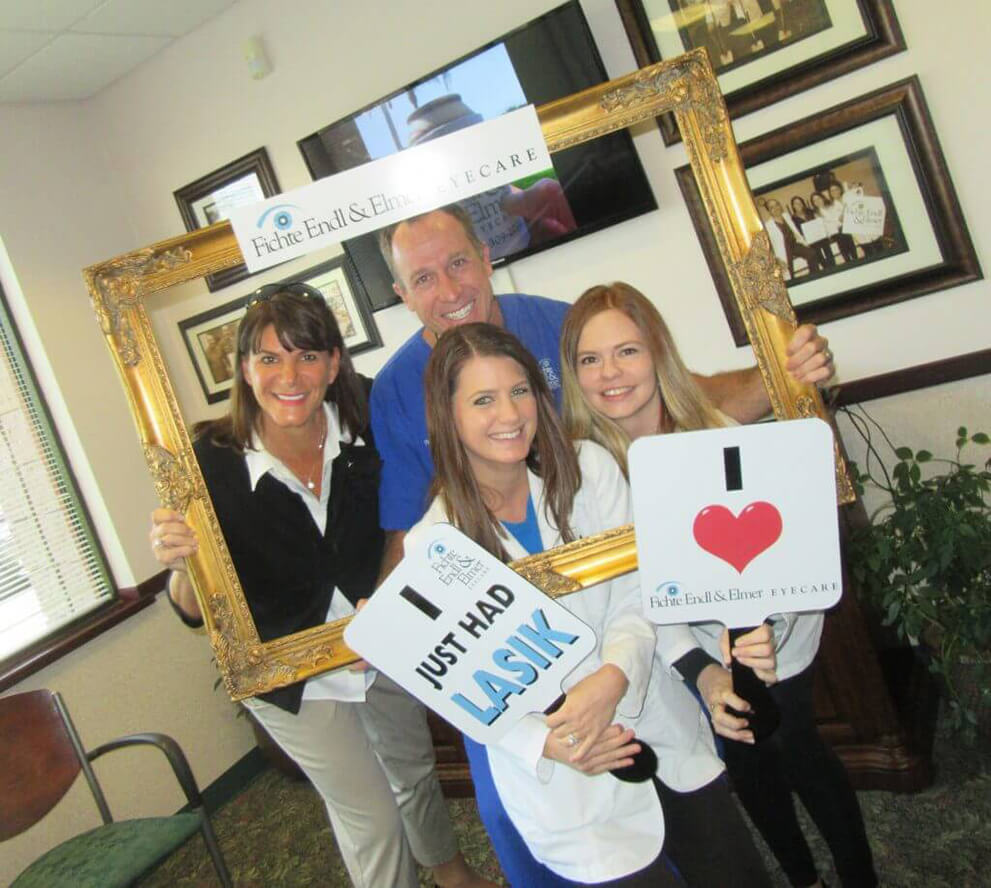
Laser In-Situ Keratomileusis, or LASIK, can correct both nearsightedness (difficulty seeing objects far away) and farsightedness (difficulty seeing objects up close), with or without astigmatism.
LASIK Eye Surgery in Buffalo
At Fichte, Endl & Elmer Eyecare in the Buffalo area, you have access to several forms of LASIK including traditional and all-laser procedures. If you are between 18 and 55 years of age and have not had a significant change in your prescription in the past year, you may be a candidate! Call 1-800-309-2020 today to schedule a comprehensive consultation so we can determine the LASIK procedure that is right for you!
People over the age of 55 or those with certain medical conditions including pregnancy and eye disease may not be eligible for LASIK. Every patient is unique. Let us determine the right treatment plan for you!
FAQ
Check List When Choosing A LASIK Surgeon
- The surgeon lives locally and does not “Fly In” from out of town one day a week to operate on patients.
- Your surgeon is board-certified.
- Your surgeon offers All Laser Blade-Free custom procedures
- In the event of a complication or emergency your surgeon will be able to see you.
1: How Reliable Are LASIK Surgery Reviews?
When considering LASIK or other elective surgery, it’s wise to learn as much as you can about the procedure and surgeons in your area. The Internet is a great place to begin your research and locate LASIK doctors near you.
But when choosing a LASIK surgeon, online reviews should be only one factor among many that you consider.
Online reviews are available for virtually any product or service, and the variation in reviews is as varied as the personalities and experiences of the people who write them. Many LASIK surgery reviews posted online often don’t provide an accurate representation of the overall satisfaction most patients have with their LASIK doctors.
When choosing a LASIK surgeon, there is no substitute for a face-to-face consultation and dialog. Many LASIK doctors offer free, no-obligation consultations so you can get to know them and decide if LASIK is right for you. Others offer free information meetings for groups of potential LASIK candidates.
Recommendations from friends you trust also can be very helpful.
2: Fixing LASIK Complications: How to begin.
Occasionally, complications occur even when your procedure is performed by a highly skilled and experienced LASIK surgeon using the latest technology. Thankfully, most LASIK complications can be successfully managed by your LASIK surgeon or eye doctor. The first step if you are unsatisfied with your LASIK outcome or are experiencing bothersome symptoms is to return to your LASIK surgeon for a thorough evaluation and consultation. If your surgeon cannot resolve your problems to your satisfaction, seek a second opinion from another eye doctor who has experience managing LASIK complications. Keep in mind that complications from LASIK usually can be successfully managed medically or with follow-up care. The expected frequency and severity of complications vary, depending on how much nearsightedness, farsightedness and/or astigmatism you have prior to the procedure and other factors.
3: Can LASIK Correct Astigmatism?
Astigmatism, like nearsightedness and farsightedness, is a common vision problem (called a refractive error) that usually can be fully corrected with LASIK surgery. Astigmatism causes the rays of light entering through different parts of the eye to focus unequally so that they do not ever form a single spot. Some rays may focus on the retina, but other rays focus in front of or behind the retina. Things look blurry because images are not ever focused clearly on the retina.
Lasers approved by the Food and Drug Administration (FDA) for LASIK performed in the United States can correct astigmatism. The maximum amount of astigmatism LASIK can correct depends on many factors, including the type and magnitude of your astigmatism and the health and thickness of your cornea.
If some astigmatism remains after a LASIK procedure, it often can be fully corrected with a follow-up care. Your eye doctor can provide more details about this at your LASIK consultation. Your LASIK surgeon will discuss astigmatism and how it may affect your LASIK surgery during your LASIK consultation.
4: Blurry Vision During Recover From LASIK.
Blurry vision is common immediately after LASIK and should be expected during the early stages of your LASIK recovery. You will have a number of follow-up visits after your LASIK surgery. Your eye doctor will examine your eyes and monitor your vision at these visits. Some blurriness and fluctuation of vision is not unusual as your eyes recover after LASIK and it may take up to a few months for this to resolve completely. If you feel your vision is too blurry for safe driving or other activities during your LASIK recovery, ask your eye doctor if a temporary pair of prescription eyeglasses is a good idea. Ask your LASIK surgeon about his or her experience dealing with issues related to blurriness.
5: Swimming After LASIK.
During the early stages of your LASIK recovery, it’s important to avoid swimming and other water-related activities that could increase the risk of contaminated water getting in your eyes and causing an infection.
Different LASIK surgeons may have different recommendations about when you can resume swimming and other water activities during your LASIK recovery. Ask your LASIK surgeon when it is safe for you to resume swimming and other activities during your post-op exams.
6: LASIK Recovery Tips: How To Help Your Eyes Heal After LASIK
The most important thing you can do to facilitate the LASIK recovery is to closely follow the post-op instructions given to you by your LASIK surgeon. Use all medications as directed for the time specified, even if you have no vision problems or discomfort symptoms.
Your eyes may feel dry after LASIK. Your surgeon may recommend sterile, non-preserved artificial tears very frequently in the early stages of your LASIK recovery to keep your eyes moist and comfortable and help the healing process.
Avoid rubbing your eyes or exposing your eyes to dust, wind and cigarette smoke. Wear comfortable wrap-style sunglasses outdoors to shield your eyes from dust, wind and UV rays. Also, wear protective safety glasses or sports goggles when performing any activities that could increase your risk of eye injuries. Finally, if you have any unusual eye or vision symptoms during your LASIK recovery, call your eye doctor immediately for advice.
7: LASIK Risks And Benefits: Making An Informed Decision.
The benefits of LASIK surgery are clear, functional vision that may eliminate or reduce dependence on eyeglasses or contact lenses. But like any medical or surgical procedure, LASIK has associated risks and potential complications. Here are some LASIK complications cited by the U.S. Food and Drug Administration, which oversees the safety of LASIK in the United States:
- Some patients experience reduced visual acuity. Some LASIK patients lose the ability to see some of the small letters near the bottom of an eye chart after LASIK surgery, even with the help of glasses or contact lenses.
- Some patients develop debilitating visual symptoms. Some LASIK patients experience glare, halos, and/or ghost images that can seriously affect vision.
- Some patients do not see as well in situations of low contrast, such as at night or in fog, after LASIK, compared with their vision with glasses or contact lenses before LASIK.
- Some people are under-treated or over-treated. Most LASIK patients can see 20/20 without glasses or contacts after surgery, but some may require an additional care due to an under-correction or over-correction of their vision.
- Some people develop severe dry eye syndrome. Some LASIK patients are unable to produce enough tears to keep their eyes moist and comfortable after surgery. Dry eyes are uncomfortable, can cause redness, and can cause intermittent blurry vision and other symptoms. These symptoms can be permanent, even with frequent use of artificial tears and other dry eye treatments.
- For some farsighted patients, results may diminish with age. The level of improved vision after LASIK surgery may decrease _with age.
- Long-term data are not available. The safety and effectiveness of LASIK surgery over the long-term is not known.
Before deciding whether to have vision correction surgery, you should carefully weigh the risks and benefits of LASIK to decide if the procedure is right for you. Your LASIK surgeon can give you more specific information about your particular risks during your LASIK consultation.
8: Why Do Some Other Places Advertise Such A Low Price For LASIK?
Many places advertise and unbelievably low price for LASIK. This is usually a to get you into the office, spend your time having the evaluation, then most are told they don’t qualify for the low price. Their low price is based on a very small glasses prescription. So small in fact that many people with that prescription can see well enough to pass a driver’s test with no glasses. As your prescription goes up, their cost for LASIK goes up! Most people end up paying the usual and customary LASIK fees and not the low advertised price.


